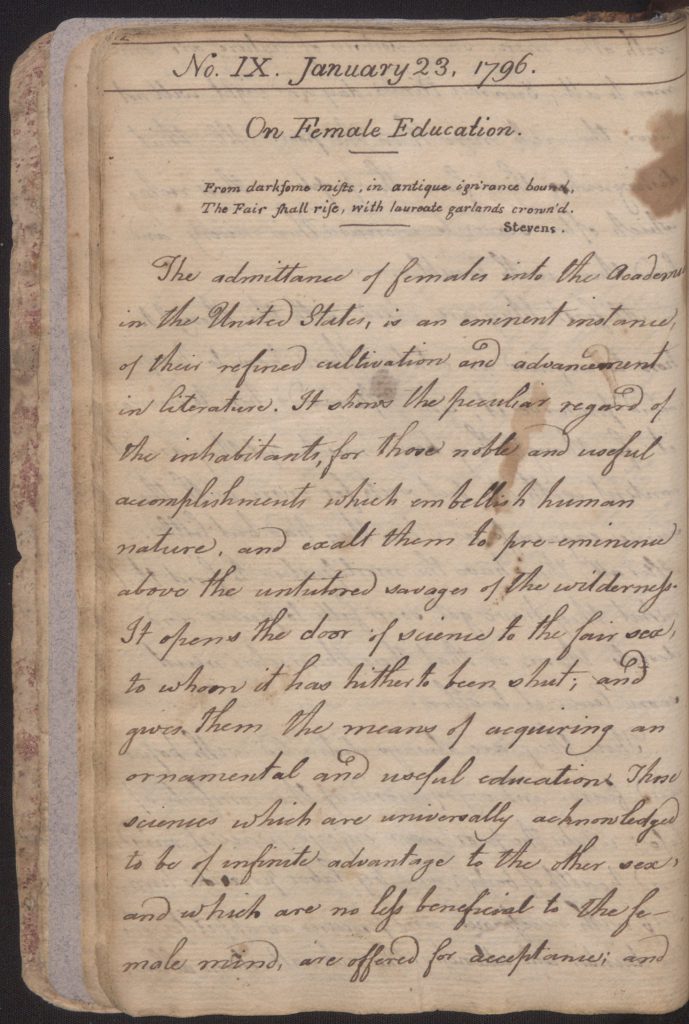This post is the eighth and final part of our continuing series on Dr. Juliette Paul's English 4300 class and their research on an early American manuscript in Special Collections.
By an Anonymous English Major, Recently Graduated
While researching the origins of a mysterious manuscript that was donated to Ellis Library many years ago, our Early American Literature class learned not only about who might have written the book, when, and why, we also learned a great deal about what life was like in the time period in which it was written. The Lucubrator is a commonplace book, written in late eighteenth-century America. It includes many essays, one of which, “On Female Education,” helps to reveal how eighteenth-century readers felt about the roles of women in society.
The author of the essay begins by recalling the recent opening of a local school for women: “The admittance of females into the Academy in the United States, is an eminent instance, of their refined cultivation and advancement in literature.” The academy to which the author refers is likely the Young Ladies Academy of Philadelphia. The opening of this particular academy would have been deeply significant to many Americans, as it was, according to Marion B. Savin and Harold J. Abrahams, “the first chartered institution for the higher education of young women in the United States and perhaps in the world” (59). The Academy was established on June 4, 1782, by John Poor, and, five years later, on January 9, 1792, it was granted a charter by the laws of Pennsylvania. By that time, one hundred women were in attendance. They studied the expected subjects, such as reading, writing, math, and history. They also studied singing, piano, and astronomy.
It was considered a prestigious accomplishment to graduate from the Academy, though often completion meant women might be better wives and mothers, rather than opening doors for careers. In James A. Neal’s An Essay on the Education and Genius of the Female Sex (1795), he writes, “When admitted to an equal participation of the illuminating beams of science, we observe women rising to the most conspicuous and enviable state of eminence” (2). Neal published his Essay on Education with his account of the Academy’s commencement activities held on December 18, 1794. Neal’s praise for the Academy shows his faith in women’s intellectual capabilities, but his was not the prevailing opinion of the time. Indeed, when Benjamin Rush delivered an address to the Academy on July 28, 1787, he made glowing remarks on female learning, but only because he believed that receiving a liberal education would make a girl “an agreeable companion to a sensible man” (79).
Domestic life was quite important in the eighteenth century and women often played an important role in making domestic life run properly. The essay “On Female Education” seems to convey this idea. Its author writes of women: “If they are never to fill a public seat or harangue in public, will they never have an occasion to read in a company of friends, or, to teach what they have leart [sic] to their families and children?” While researching this essay in the The Lucubrator, we learned that when it was written, America was beginning to come around to the idea that women deserve an education in order to become happier, more productive people.
People, most often, will be as great as they are allowed to be. When we continue to treat women as inferior, less intelligent people, it makes it hard for them to prove otherwise. Many are not given the chance to better themselves, and when they are, their accomplishments are overlooked by people who only seem to pay attention to what they want to see. While there is still a long way to go before people who are not white men are treated with equal amounts of respect, education continues to be the best route to achieving this.
Works Cited
Rush, Benjamin. Essays, Literary, Moral & Philosophical (Philadelphia, 1798).
Savin, Marion B. and Harold J. Abrahams. “The Young Ladies’ Academy of Philadelphia.” History of Education Journal. Vol. 8. No. 2 (Winter, 1957): 68-67.
